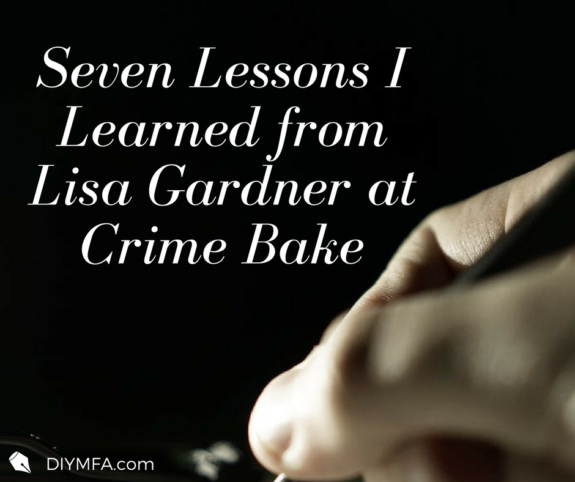In November, I attended the New England Crime Bake, an annual conference held in the Boston area for crime writers and lovers of crime writing. This year’s guest of honor was New York Times best-selling author Lisa Gardner. She taught a Master Class on character development filled with amazing insights and advice. Below are a few takeaways:
Establish External and Internal Goals
Characters who resonate with readers have both external and internal goals (who this character wants to be or who they want to become). Gardner uses her series character, Boston Detective D.D. Warren, as an example:
D.D.’s external goal is to always catch the bad guy. But Gardner says this goal isn’t enough. It needs more power. So she takes it a step further when she reveals what pushes her protagonist. D.D.’s parents were academics, and D.D. doesn’t have a PhD. Her need for self-worth is what drives her.
D.D.’s internal goal is to try to be a human being. She has confidence in herself as a cop, but she knows normal people do certain things, and she wants to do these things too. She tries to juggle work, family, a puppy. This personal texture makes her relatable to the reader.
She says in her books, characters sometimes discover a goal they didn’t realize they had. She refers to it as the “light bulb moment”. In Gardner’s Find Her, the reader meets kidnap victim Flora Dane. Flora resents her mother, but doesn’t understand why. Through her journey, Flora realizes she struggled to stay alive so she could return to her mother. She survived something she isn’t sure she wanted to survive, and she blames her mother for it.
Make the Hero and Villain Complimentary
Gardner says the protagonist and antagonist have to go together. Their goals, strengths, and weaknesses need to be an equal match and a natural foil for each other. When the going gets tough (the black moment), the hero rises to the challenge while the villain disintegrates or devolves.
Villains should have weaknesses and strengths to set them apart. A moral code, she suggests, is one way to make them interesting. Gardner uses Ted Bundy as an example: Bundy murdered and mutilated over thirty women, but he wouldn’t steal an uninsured car because he thought it was cruel.
Vulnerability is compelling
In some thrillers, homicide cops lack awareness. In the real world this isn’t true. Cops read themselves and their emotions. We don’t want heroes to go on soliloquies, she says, but there has to be some self-awareness. Jobs like these take a toll. Writers can show a character’s weakness through interactions with other people. A character’s coping mechanism is what keeps them from being cliché.
She recommends speaking to someone in law enforcement about how they decompress. (They are unlikely to go to cop bars.) Olivia Kiernan’s character in Too Close to Breathe cares for a bonsai plant. These kind of unique details will set your character apart and make them relatable.
Use Supporting characters
Supporting characters also provide insight into your main character. She returns to her protagonist, D.D. Warren as an example. D.D. looks up to an older detective because she misses an approving father figure.
In her new book, Look for Me, a family is murdered. Everyone is dead, except a sixteen-year-old girl who goes missing. Statistically, the teenager is the next victim or participated in the killing. Gardner uses the point of view of secondary characters to reveal more about the girl.
Fulfill Reader Expectations for Beginnings and Endings
Gardner suggests when you introduce your book think of it like a cocktail party. When we meet people we don’t reveal deep personal beliefs or details. Instead, establish goals in the first chapter: who is your character; what are they trying to do. Think of it as the outer layer of an onion. From here, you can transition into the wider world.
The end of the book doesn’t have to be tidy, Gardner says, but readers respond to a novel when the character ends in a better place. (The character has gained or learned something.) Readers like a sense of closure, for good characters to endure, and consequences for bad things.
Don’t Stress the First Draft
It’s okay to have too much in the first draft. You can have all the mistakes you want. Just get the story out. (No one will see it.) Then really focus on where your characters are going.
If your characters seem flat, Gardner says, examine whether or not they have worthy goals, strengths and weaknesses, hidden depths. She reminds us a book is a discovery process. With each plot twist and turn, we want to discover how our character evolves.
The Value of the Black Moment
One purpose of the black moment, an incident that steals the protagonist’s hope there’s a solution, is for characters to reflect inward. At the beginning of a book, for instance, it may be about catching a bad guy. But at the end of the novel, it should mean something to the character: a fresh insight to their life or their value system. She returns to Flora and D.D. as examples.
Flora realizes she needs to reconnect with her mother and find a way to move forward; D.D. realizes she is going to screw up being a mom, and she needs to forgive herself. (Sometimes having characters forgive themselves in the most human thing you can do.)
After reading this piece, can you think of a character that resonates with you as a reader? Are there ways you can make characters in your stories more dynamic and relatable?
 Stacy Woodson is a U.S. Army Special Operations veteran and a self-declared fitness junkie. She loves a good conspiracy story and has penned one of her own. She believes in the power of a good writing community and how it can elevate your writing. She is a contributor to DIY MFA’s 5onFri and a Claymore finalist. She’s represented by John Talbot at the Talbot Fortune Agency.
Stacy Woodson is a U.S. Army Special Operations veteran and a self-declared fitness junkie. She loves a good conspiracy story and has penned one of her own. She believes in the power of a good writing community and how it can elevate your writing. She is a contributor to DIY MFA’s 5onFri and a Claymore finalist. She’s represented by John Talbot at the Talbot Fortune Agency.







